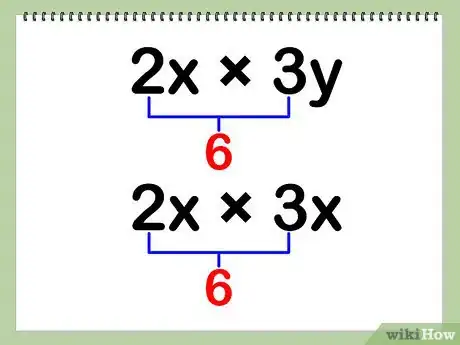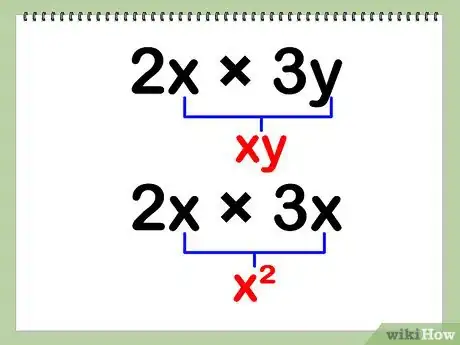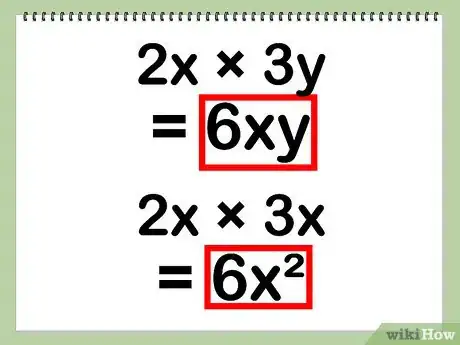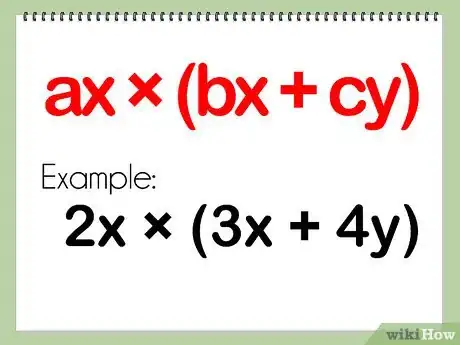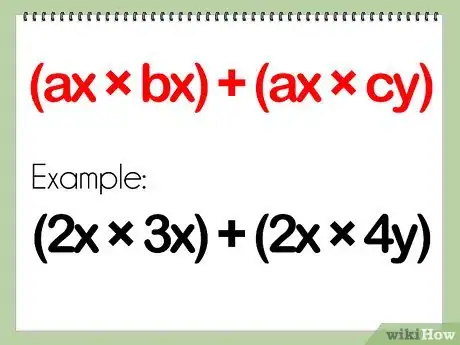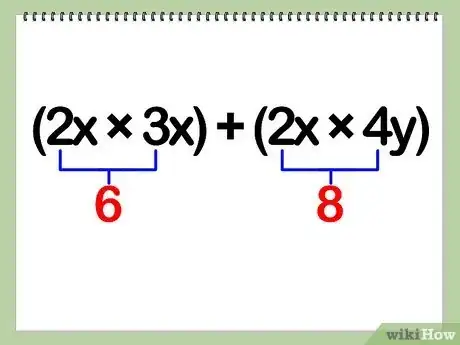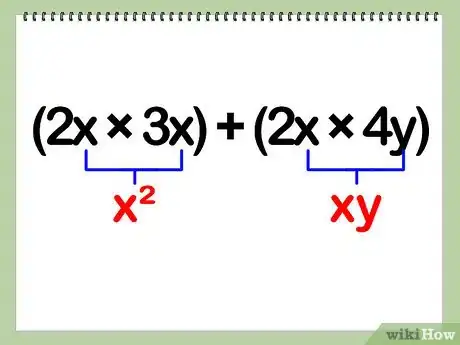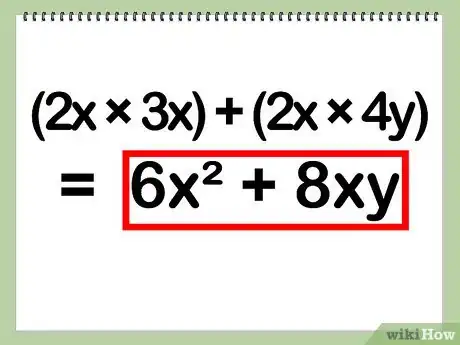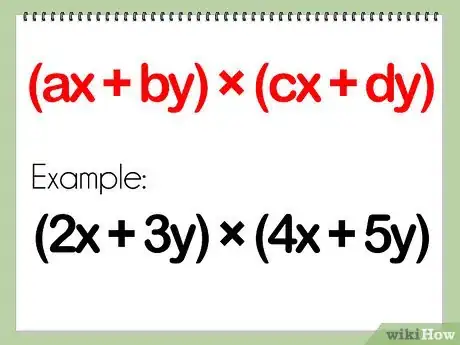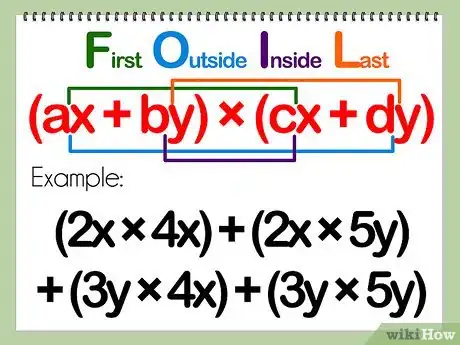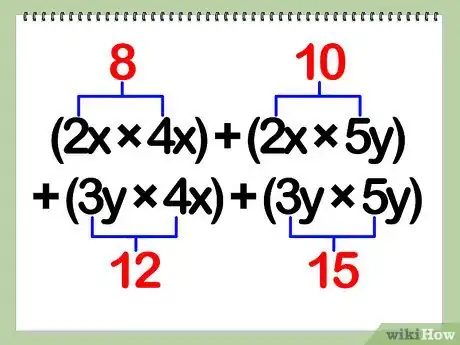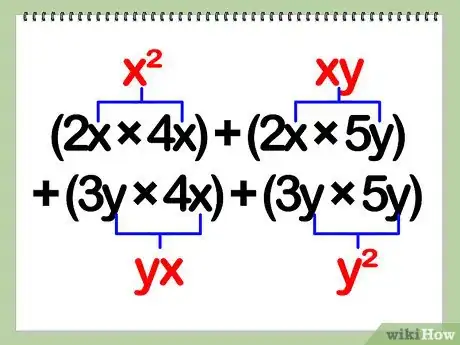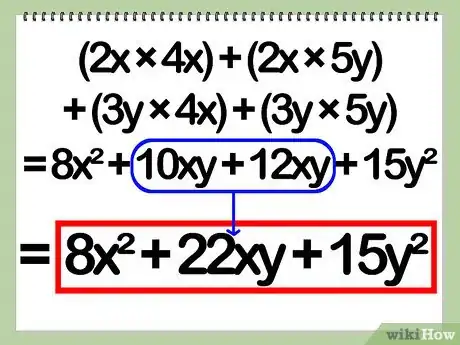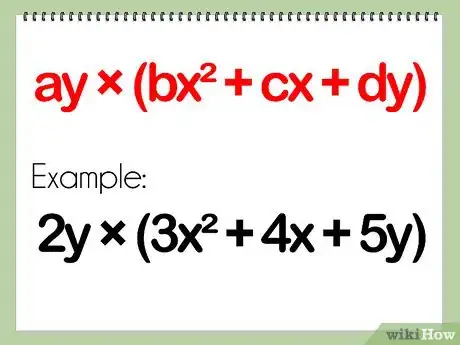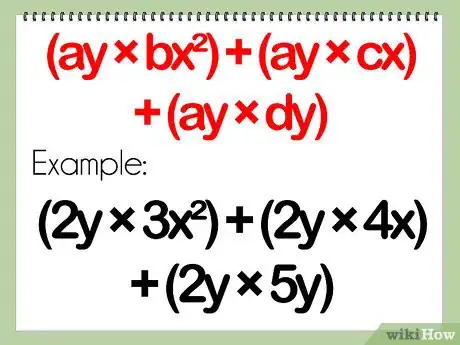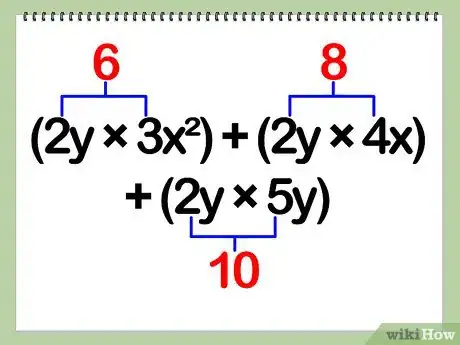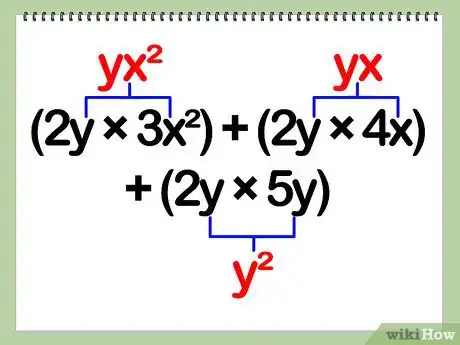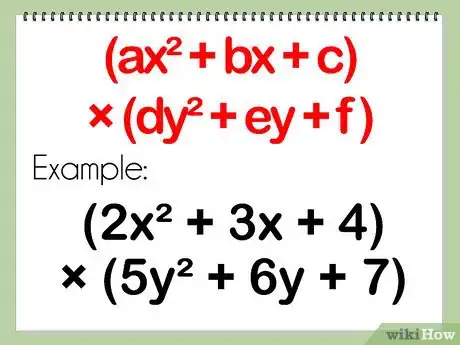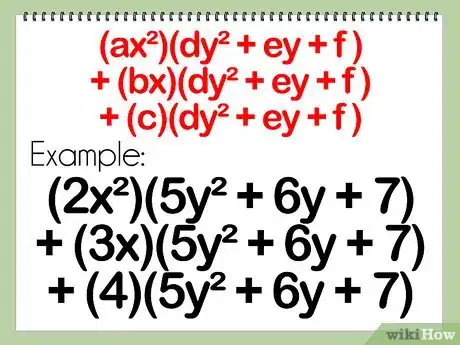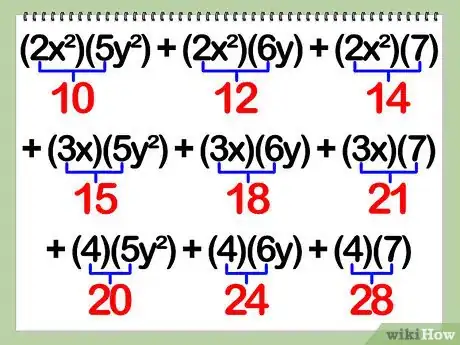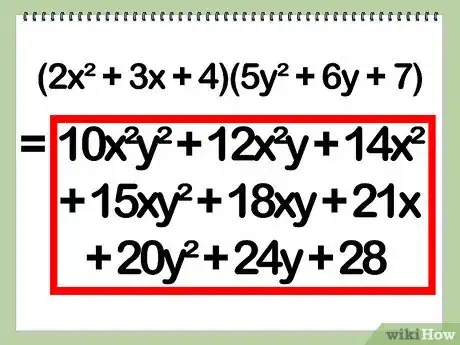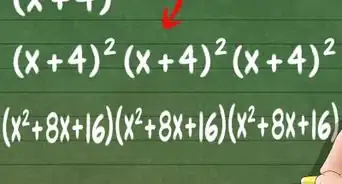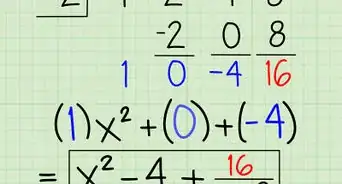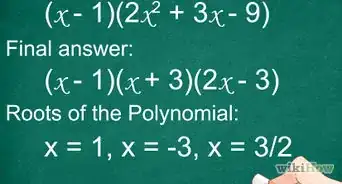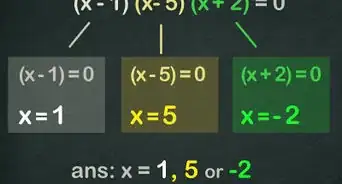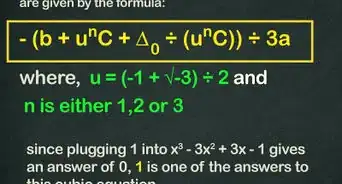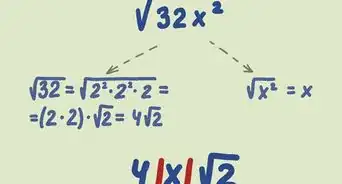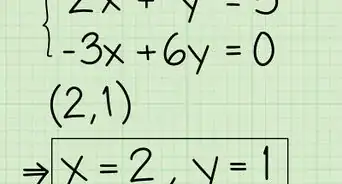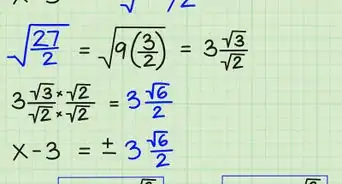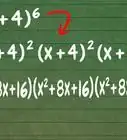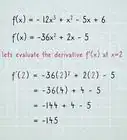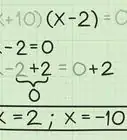wikiHow is a “wiki,” similar to Wikipedia, which means that many of our articles are co-written by multiple authors. To create this article, volunteer authors worked to edit and improve it over time.
This article has been viewed 36,593 times.
Learn more...
Polynomials are mathematical structures with strands of terms made up of numerical constants and variables. There are certain ways that polynomials must be multiplied based on how many terms are contained within each one. Here's what you need to know about how to do it.
Steps
Multiplying Two Monomials
-
1Examine the problem. A problem involving two monomials will only involve multiplication. There will be no subtraction or addition.
- A polynomial problem involving two monomials, or two single-term polynomials, will look something like: (ax) * (by); or (ax) * (bx)'
- Example: 2x * 3y
- Example: 2x * 3x
- Note that a and b represent constants or numerical digits, while x and y represent variables.
-
2Multiply the constants.[1] The constants refer to the numerical digits in the problem. These are multiplied as they usually would be according to the standard times table.
- In other words, during this part of the problem, you are multiplying a and b together.
- Example: 2x * 3y = (6)(x)(y)
- Example: 2x * 3x = (6)(x)(x)
Advertisement -
3Multiply the variables. The variables refer to the letters in the equation. When you multiply these variables, different variables will simply be combined together while like variables will become squared.[2]
- Note that when you multiply a variable by a like variable, you raise that variable by another power.
- In other words, you are multiplying the x and y or x and x together.
- Example: 2x * 3y = (6)(x)(y) = 6xy
- Example: 2x * 3x = (6)(x)(x) = 6x^2
-
4Write your final answer. Due to the simplified nature of this problem, you will not have any like terms that you need to combine.
- The result of (ax) * (by) equals abxy. Similarly, the result of (ax) * (bx) equals abx^2.
- Example: 6xy
- Example: 6x^2
Multiplying a Monomial and a Binomial
-
1Examine the problem. A problem involving a monomial and a binomial will involve one polynomial that only has a single term. The second polynomial will have two terms, which will be separated by either a plus sign or a minus sign.[3]
- A polynomial problem involving a monomial and a binomial will look something like: (ax) * (bx + cy)
- Example: (2x)(3x + 4y)
-
2Distribute the monomial to both terms in the binomial. Rewrite the problem so that all the terms are separate by distributing the single-term polynomial to both terms in the two-term polynomial.[4]
- After this step, the new rewritten form will look something like: (ax * bx) + (ax * cy)
- Example: (2x)(3x + 4y) = (2x)(3x) + (2x)(4y)
-
3Multiply the constants. The constants refer to the numerical digits in the problem. These are multiplied as they usually would be according to the standard times table.
- In other words, during this part of the problem, you are multiplying a, b, and c together.
- Example: (2x)(3x + 4y) = (2x)(3x) + (2x)(4y) = 6(x)(x) + 8(x)(y)
-
4Multiply the variables. The variables refer to the letters in the equation. When you multiply these variables, different variables will simply be combined together. When you multiply a variable by a like variable, though, you raise that variable by another power.
- In other words, you are multiplying the the x and y portions of the equation.
- Example: (2x)(3x + 4y) = (2x)(3x) + (2x)(4y) = 6(x)(x) + 8(x)(y) = 6x^2 + 8xy
-
5Write your final answer. This type of polynomial problem is also simple enough to usually avoid the need for combining like terms.
- The result will look something like: abx^2 + acxy
- Example: 6x^2 + 8xy
Multiplying Two Binomials
-
1Examine the problem. A problem involving a two binomials will involve two polynomials, each with two terms that are separated by either a plus sign or a minus sign.
- A polynomial problem involving two binomials will look something like: (ax + by) * (cx + dy)
- Example: (2x + 3y)(4x + 5y)
-
2Use FOIL to distribute the terms appropriately. FOIL is an acronym used to explain how terms are distributed. Distribute first terms, outside terms, inside terms, and last terms.[5]
- After this, your rewritten polynomial problem will effectively look like: (ax)(cx) + (ax)(dy) + (by)(cx) + (by)(dy)
- Example: (2x + 3y)(4x + 5y) = (2x)(4x) + (2x)(5y) + (3y)(4x) + (3y)(5y)
-
3Multiply the constants. The constants refer to the numerical digits in the problem. These are multiplied as they usually would be according to the standard times table.[6]
- In other words, during this part of the problem, you are multiplying a, b, c, and d together.
- Example: (2x)(4x) + (2x)(5y) + (3y)(4x) + (3y)(5y) = 8(x)(x) + 10(x)(y) + 12(y)(x) + 15(y)(y)
-
4Multiply the variables. The variables refer to the letters in the equation. When you multiply these variables, different variables will simply be combined together. When you multiply a variable by a like variable, though, you raise that variable by another power.
- In other words, you are multiplying the the x and y portions of the equation.
- Example: 8(x)(x) + 10(x)(y) + 12(y)(x) + 15(y)(y) = 8x^2 + 10xy + 12xy + 15y^2
-
5Combine any like terms and write your final answer. This type of problem is complex enough to potentially produce like terms, meaning two or more end terms that share the same ending variable. If this happens, you should add or subtract the like terms as needed to determine your final answer.
- The result will look something like: acx^2 + adxy + bcxy + bdy^2 = acx^2 + abcdxy + bdy^2
- Example: 8x^2 + 22xy + 15y^2
Multiplying a Monomial and a Three-Term Polynomial
-
1Examine the problem. A problem involving a monomial and a three-term polynomial will involve one polynomial that only has a single term. The second polynomial will have three terms, which will be separated by either a plus sign or a minus sign.
- A polynomial problem involving a monomial and a three-term polynomial will look something like: (ay) * (bx^2 + cx + dy)
- Example: (2y)(3x^2 + 4x + 5y)
-
2Distribute the monomial to all three terms in the polynomial. Rewrite the problem so that all the terms are separate by distributing the single-term polynomial to both terms in the three-term polynomial.
- Rewritten, the new equation should look similar to: (ay)(bx^2) + (ay)(cx) + (ay)(dy)
- Example: (2y)(3x^2 + 4x + 5y) = (2y)(3x^2) + (2y)(4x) + (2y)(5y)
-
3Multiply the constants. The constants refer to the numerical digits in the problem. These are multiplied as they usually would be according to the standard times table.
- Again, for this step you are multiplying a, b, c, and d together.
- Example: (2y)(3x^2) + (2y)(4x) + (2y)(5y) = 6(y)(x^2) + 8(y)(x) + 10(y)(y)
-
4Multiply the variables. The variables refer to the letters in the equation. When you multiply these variables, different variables will simply be combined together. When you multiply a variable by a like variable, though, you raise the power of the variable.
- So multiply the the x and y portions of the equation.
- Example: 6(y)(x^2) + 8(y)(x) + 10(y)(y) = 6yx^2 + 8xy + 10y^2
-
5Write your final answer. Due to the single-term monomial at the beginning of this equation, you don't need to combine like terms.
- When finished, the final answer should be: abyx^2 + acxy + ady^2
- Example substituting sample values for constants: 6yx^2 + 8xy + 10y^2
Multiplying Two Polynomials
-
1Examine the problems. Each has two three-term polynomials with either a plus sign or a minus sign between terms.
- A polynomial problem involving monomial and two binomials will look something like: (ax^2 + bx + c) * (dy^2 + ey + f)
- Example: (2x^2 + 3x + 4)(5y^2 + 6y + 7)
- Note that the same practices used to multiply two three-term polynomials should also be applied to polynomials with four or more terms.
-
2Treat the second polynomial as a single term.[7] The second polynomial should remain whole.
- The second polynomial refers to the (dy^2 + ey + f) portion of the equation.
- Example: (5y^2 + 6y + 7)
-
3Distribute each portion of the first polynomial to the second polynomial. Each piece of the first polynomial should be broken up and distributed to the second polynomial as a whole.
- At this point, the equation is something along the lines of: (ax^2)(dy^2 + ey + f) + (bx)(dy^2 + ey + f) + (c)(dy^2 + ey + f)
- Example: (2x^2)(5y^2 + 6y + 7) + (3x)(5y^2 + 6y + 7) + (4)(5y^2 + 6y + 7)
-
4Distribute each term. Distribute each newly single-term polynomial over all of the terms in the remaining three-term polynomial.
- Essentially, the equation at this point is something along the lines of: (ax^2)(dy^2) + (ax^2)(ey) + (ax^2)(f) + (bx)(dy^2) + (bx)(ey) + (bx)(f) + (c)(dy^2) + (c)(ey) + (c)(f)
- Example: (2x^2)(5y^2) + (2x^2)(6y) + (2x^2)(7) + (3x)(5y^2) + (3x)(6y) + (3x)(7) + (4)(5y^2) + (4)(6y) + (4)(7)
-
5Multiply each of the constants. The constants refer to the numerical digits in the problem. These are multiplied as they usually would be according to the standard times table.
- In other words, during this part of the problem, you are multiplying a, b, c, d, e and f portions.
- Example: 10(x^2)(y^2) + 12(x^2)(y) + 14(x^2) + 15(x)(y^2) + 18(x)(y) + 21(x) + 20(y^2) + 24(y) + 28
-
6Multiply each of the variables. The variables refer to the letters in the equation. When you multiply these variables, different variables will simply be combined together. When you multiply a variable by a like variable, though, you raise that variable by another power.
- In other words, you are multiplying the the x and y portions of the equation.
- Example: 10x^2y^2 + 12x^2y + 14x^2 + 15xy^2 + 18xy + 21x + 20y^2 + 24y + 28
-
7Combine like terms and write your final answer. This type of problem is complex enough to potentially produce like terms, meaning two or more end terms that share the same ending variable. If this happens, you should add or subtract the like terms as needed to determine your final answer. If not, no additional addition or subtraction is needed.
- Example: 10x^2y^2 + 12x^2y + 14x^2 + 15xy^2 + 18xy + 21x + 20y^2 + 24y + 28
References
- ↑ http://www.mathsisfun.com/algebra/polynomials-multiplying.html
- ↑ https://sciencing.com/how-to-multiply-monomials-13712234.html
- ↑ https://www.mathsisfun.com/algebra/polynomials-multiplying.html
- ↑ https://www.mathsisfun.com/algebra/polynomials-multiplying.html
- ↑ https://mathbitsnotebook.com/Algebra1/Polynomials/PObinomial.html
- ↑ https://mathbitsnotebook.com/Algebra1/Polynomials/PObinomial.html
- ↑ http://www.sparknotes.com/math/algebra1/polynomials/section3.rhtml
About This Article
To multiply polynomials, start by distributing each portion of the first polynomial to the second polynomial. Then, distribute each single-term polynomial over all of the terms in the three-term polynomial. Next, multiply all of the numerical digits in the problem, and then multiply each of the variables. Finally, combine any like terms to get your final answer. To learn how to multiply 2 monomials or 2 binomials, read on!

